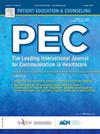在患者-临床环境中证明支持性信息质量测量的必要性和有效性和可靠性
IF 3.1
2区 医学
Q2 PUBLIC, ENVIRONMENTAL & OCCUPATIONAL HEALTH
引用次数: 0
摘要
目的在医疗保健日益严重的问题是相互作用中,病人的症状被临床医生无效。支持性信息质量的关系科学构建——或为他人提供帮助而产生的行为,被认为需要这种帮助——可以在临床医生的无效研究中得到利用,特别是在特定的沟通互动中。鉴于最近将关系科学与临床沟通结合起来的呼声,以及越来越多的研究将临床医生定位为患者的支持来源,本研究的目的是在新的患者-临床沟通背景下测试该量表。方法数据来源于一个更大的项目,旨在构建一种无效通信的测量方法。本研究将样本随机分为两组,采用校正(探索性因子分析;EFA; n = 235)和验证(验证性因子分析;CFA; n = 244)方法。全民教育产生了一个因素。对一阶单因素和三因素模型以及二阶三因素模型均进行了CFA分析。结果一阶三因素模型的拟合效果优于单因素模型,与二阶三因素模型相当。结构方程模型对二阶三因素模型进行了满意的检验,得到了一个可接受的模型。内部一致性非常好。结论该量表在患者-临床情境下的适应性是评估临床医生无效评价中临床医生对患者信息质量健康结果的一种方法。这是临床传播学与相关科学文献整合的又一进步,拓展了临床传播学理论化的思路。实践意义能够在患者-临床环境中测量支持性信息的质量,可以对临床医生促进或阻碍患者整体健康的生理机制产生新的见解,例如炎症的增加,这在相关科学文献中得到了证明,并对患者的身体健康有影响。本文章由计算机程序翻译,如有差异,请以英文原文为准。
Demonstrating the need for and the validity and reliability of a supportive message quality measure within the patient-clinician context
Objective
A growing problem in healthcare is interactions in which patients’ symptoms are reportedly invalidated by clinicians. The relational science construct of supportive message quality—or behavior generated to provide aid to others perceived as needing such aid—can be leveraged in the study of invalidation by clinicians, especially for a specific communication interaction. Given a recent call to integrate relational science with clinical communication and the increasing research that situates clinicians as a source of support for patients, the purpose of this study was to test this scale within the novel patient-clinician communication context.
Methods
Data were derived from a larger project seeking to construct a measure of invalidating communication. For the present study, the sample was randomly divided into two groups for a calibration (exploratory factor analysis; EFA; n = 235) and validation (confirmatory factor analysis; CFA; n = 244) approach. EFA yielded one factor. CFA was conducted for both a first-order one-factor and three-factor model and a second-order three-factor model.
Results
The first-order three-factor model was a better fit than the one-factor model and comparable to the second-order three-factor model. Structural equation modeling testing the second-order three-factor model with satisfaction yielded an acceptable model. Internal consistency was excellent.
Conclusions
The adaptation of this scale in the patient-clinician context is one way to assess the health outcomes of clinicians’ message quality toward patients in the assessment of clinician invalidation. It is a step forward in integrating the clinical communication and relational science literatures and expanding how we theorize clinical communication.
Practice Implications
Being able to measure supportive message quality in the patient-clinician context can yield novel insights into the physiological mechanisms by which clinicians facilitate or impede patients’ overall well-being, such as increased inflammation, which has been demonstrated in the relational science literature and has implications for patients’ physical health.
求助全文
通过发布文献求助,成功后即可免费获取论文全文。
去求助
来源期刊

Patient Education and Counseling
医学-公共卫生、环境卫生与职业卫生
CiteScore
5.60
自引率
11.40%
发文量
384
审稿时长
46 days
期刊介绍:
Patient Education and Counseling is an interdisciplinary, international journal for patient education and health promotion researchers, managers and clinicians. The journal seeks to explore and elucidate the educational, counseling and communication models in health care. Its aim is to provide a forum for fundamental as well as applied research, and to promote the study of organizational issues involved with the delivery of patient education, counseling, health promotion services and training models in improving communication between providers and patients.
 求助内容:
求助内容: 应助结果提醒方式:
应助结果提醒方式:


